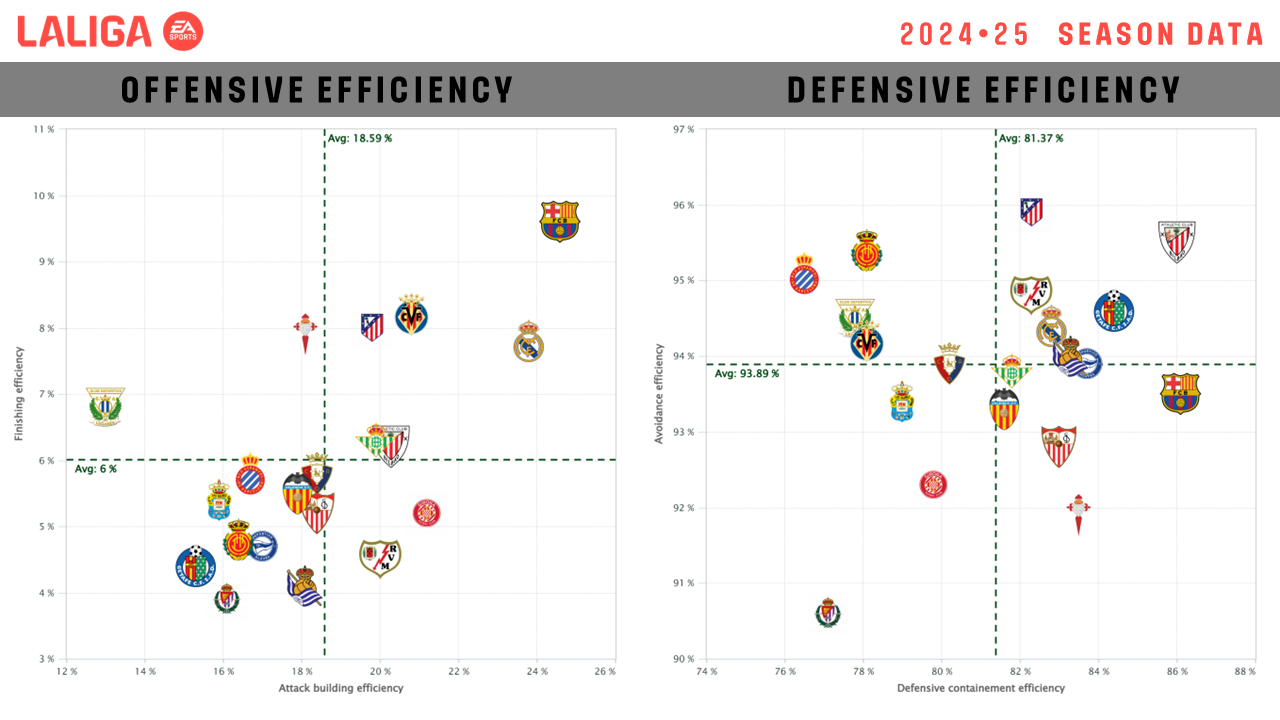
27 May The science knew who would win LALIGA: an analysis based on real data from the last two seasons
FC Barcelona vs Real Madrid: two champions the science already knew
When comparing the two giants who have shared the titles over the past two LALIGA seasons, the data reveal two different ways of dominating the game—but with a common denominator: balance across five key performance metrics.
FC Barcelona 2024/25
Under new coach Hansi Flick, FC Barcelona implemented a tactical system featuring a high defensive line and aggressive pressing. This high block approach led the team to stand out in attack penetration (24.8%) and finishing efficiency (10.3%). Barcelona also led the league in defensive containment (86%), reinforcing the idea that, although they allowed more rival possessions near their own half than some competitors (not being the best at preventing the opponent from reaching the box), they were highly effective at defending their own area.
In terms of preventing opponent penetration, Barcelona was outperformed by teams like Athletic Club. This relative vulnerability can be explained by their advanced defensive line: once the initial press was bypassed, rivals often found themselves near the goal. However, Barcelona’s defensive structure in the final third consistently neutralized the opponents’ chances. Their pass flow was also among the best in the league (16.6 passes/min), reflecting a fluid, high-tempo combinative style.
Real Madrid 2023/24
With Carlo Ancelotti at the helm, Real Madrid consolidated a vertically-oriented, yet associative game model. They led the league in pass flow (17.3 passes/min), suggesting a high-paced, connection-driven style of play, especially effective after recovering the ball. They also ranked at the top in finishing efficiency (9.55%) and attack penetration (22.8%), showing they were not only frequent attackers but also highly effective.
While not the best team at preventing opponent penetration, Real Madrid compensated with offensive firepower. Their defensive model was more focused on control in key zones than on disrupting early phases of the rival’s build-up. They also performed well in defensive containment, though they were not league leaders in that metric.
Introduction: when data explain success
In professional football, it’s often said that “some things just can’t be measured.” But from LALIGA’s Football Intelligence department, we’ve spent years conducting research that proves otherwise. One study, published in 2021 in the Journal of Sports Sciences, identified the variables that best explain why some teams win more than others over a full season (https://doi.org/10.1080/02640414.2021.1976488). To validate those conclusions, we analyzed real data from the two most recent seasons in LALIGA EA Sports (2023/24 and 2024/25), both of which occurred after the study was published. The findings not only reinforce the original model—they strengthen it: science can anticipate who will win the league.
Metrics that make the difference: the 5 keys to success
While the original study analyzed 12 game variables, we focused on 5 that proved to have the greatest impact on competitive performance. The first four capture the offensive-defensive balance, and the fifth measures the tempo of a team’s ball circulation:
- Attack penetration (Efficacy of Attack Building): the percentage of possessions that result in a real offensive action. It neutralizes volume: what matters is the quality of penetration, not how often you have the ball.
- Finishing efficiency (Efficacy of Completion): the percentage of your attacking plays that end in goals. This is the metric most directly correlated with points earned.
- Neutralizing opponent finishing (Efficacy of Defensive Containment): the percentage of opponent attacks that do not end in goals. Crucial for defending the box.
- Preventing opponent penetration (Efficacy of Avoidance): the percentage of opponent possessions that never develop into real attacking plays. Key for high-pressing teams.
- Pass flow (Pass Flow): the number of successful passes per minute of possession. It reflects the speed and cohesion of team play—essential in dominant, combinative styles.
Real outcomes: two seasons that validate the model
The metrics confirm that the LALIGA EA Sports champions of the last two seasons were not only effective but balanced. Both teams excelled in several of the five key metrics, but more importantly, maintained strong consistency across all of them.
In 2024/25, FC Barcelona led the league in attack penetration (24.8%), finishing efficiency (10.3%), defensive containment (86%), and pass flow (16.6 passes/min). Although they were not the best at preventing opponent penetration—Athletic Club led that metric—their strength in the other four areas more than compensated. Their high pressing and structured circulation proved decisive.
In 2023/24, Real Madrid earned the title with standout performance in pass flow (17.3), finishing efficiency (9.55%), and attack penetration (22.8%). Despite not leading in defensive prevention metrics, their ability to generate and convert chances at a high rhythm helped them dominate the competition.
These two cases reinforce the central idea of the research: it’s not about excelling in just one area—it’s about maintaining a competitive balance across all five key metrics.
Conclusion
Science has shown that these five metrics can explain up to 50% of a team’s points across a season. But more importantly, our analysis shows that the team that wins LALIGA is usually the one that maintains the best balance between attack, finishing, containment, and ball circulation.
FC Barcelona (2024/25) succeeded with a high-pressure, combinative, and defensively solid model. Real Madrid (2023/24) triumphed through verticality, pace, and clinical execution. Different profiles, but both aligned with the metrics that science had already identified as keys to success.
This isn’t magic. It’s football—explained by data. And yes: the science knew who would win LALIGA.


